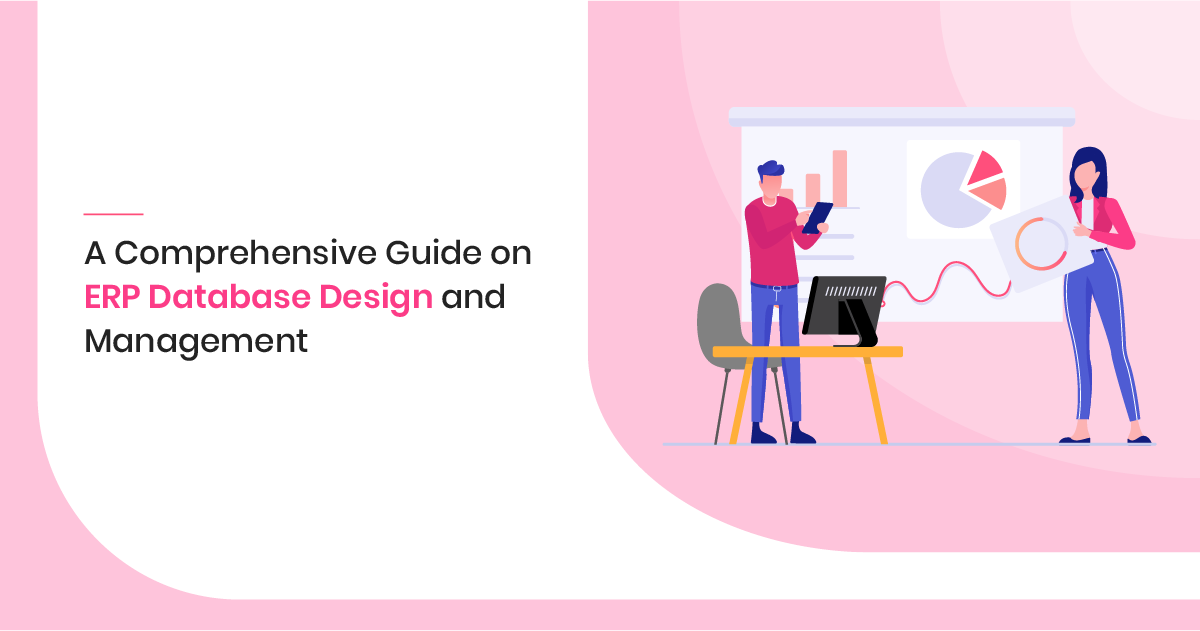ERP is undoubtedly the backbone of modern-day business. A cursory glance at the history of the business world shows that there has been a paradigm shift in the business environment. Companies all across the globe are seeking to reach more customers and higher market opportunities.
Having said that, no one could deny the benefits of deploying integrated systems in companies. Enhanced quality, maximum profit, improved performance, and higher customer satisfaction – all such things are usually a dream for myriad businesses. And to turn these visions into a beautiful reality, the best ERP software plays a pivotal role. We’ll learn about ERP database design and management in this post.
So, let’s dive deep into it!
What Is An ERP?
ERP (Enterprise Resource Planning) is basically an integrated business management software specifically designed to streamline, standardize, and integrate various business processes, such as planning, production, purchasing, order tracking, and inventory management.
In addition to this, ERP allows the automation of various business processes with the help of automatic data and information sharing. ERP consists of different modules that have the ability to run a wide range of business activities like financing, accounting, billing and invoicing, and many others.

Looking for ERP Software? Check out SoftwareSuggest’s list of the best ERP system solutions.
What Is Meant By ERP Database Design & Management?
In simple terms, ERP database design and management involve various processes that are meant to design, develop, implement, and maintain enterprise data management systems. When a database is properly designed and managed, it provides several benefits to the business, such as improved data consistency, cost-effectiveness, and higher performance.
The primary aim of ERP system database designing and management is to create logical and physical models of the proposed database system and then to implement and maintain them throughout their life cycle. We will soon discuss what is logical and physical models, and go through the development life cycle of an ERP database.
Elements of Database
To understand more about ERP database design, let’s first start with the basics and find out what comprises a database and its elements are.
Although there are several elements of the database, the main intent of this section is to provide brief coverage of the five basic elements. So, let’s discuss them one by one to have a basic understanding of a database!
- Tables: In a database system, a table is a primary unit to store data physically. As the data is stored physically in a table, it requires storage space on the host computer. Like spreadsheet software, tables have rows and columns known as ‘records’ and ‘fields’, respectively.
- Data Types: What kind of data can be stored in a database column is actually determined by a data type. Although there are many data types, three of them are the most commonly used. They are as follows:
-
- Alphanumeric: Used to store characters, special characters, and numbers.
- Numeric: Used to store only numeric values.
- Date & Time: Used to store the values of date and time.
- Forms: A form basically serves as an input tool to put data into a table. It can include action buttons like recording or deleting a record. For example, when you order items, let’s say clothes, from Myntra.com, you actually use a form that updates the Myntra database.
- Queries: Queries can be termed as a predefined set of instructions aiming to ask questions about the tables’ data. The final output of a query can either be displayed on the screen or sent as a report. Also, queries do not store the data, they only store the instructions and generate outputs based on those instructions.
- Reports: As mentioned in the above point, the results of a query can be sent as a report. Formatting the results into a report allows easy analysis and reading. Moreover, reports can be used to perform simple as well as complex calculations.
Kinds Of ERP Database Designing Techniques
There are two major types of ERP database designing techniques. Let’s read about them one by one!
1. Normalization
In the normalization technique, larger tables are divided into smaller tables, and then they are connected using relationships. The normalization process’s primary aim is to reduce data redundancy and remove anomalies related to insertion, deletion, and updates.
Edgar Codd, the inventor of the relational model, introduced the First Normal Form with the proposition of the theory of normalization. He continued to extend his theory with the Second and Third Normal Form. Later on, Raymond F. Boyce introduced the theory of the Boyce-Codd Normal Form.
Let’s have a look at the normal database forms!
- 1NF (First Normal Form)
- 2NF (Second Normal Form)
- 3NF (Third Normal Form)
- BCNF (Boyce-Codd Normal Form)
- 4NF (Fourth Normal Form)
- 5NF (Fifth Normal Form)
- 6NF (Sixth Normal Form)
2. ER Modeling
ER (Entity Relationship) Modeling is a sophisticated approach to an ERP system database designing. It defines various data elements in a precise manner and also shows their relationship with specific software.
ER model basically consists of:
Now, to understand how ER modeling is done, let’s go through the following example!
Mr. X is an employee at ABC company. Mr. X can be called an ‘Entity’. He has various ‘Attributes’, such as name, age, phone number, etc. Now, each of these attributes holds some ‘Values’. An attribute can either have only one value or more than one value. For example, Mr. X’s age will have a single value, right? But his phone number can have multiple values.
It is also important for you to know that entities can also have relationships with each other. Mr. X is assigned a computer, which is also an entity. This clearly shows the relationship between the two entities; that is, Mr. X is using his computer OR the computer is being used by Mr. X.
Therefore, while doing ER Modeling, entities, attributes, values, and relationships among entities are modeled.
Relationship of Database With ERP
You might be willing to know how ERP and database systems are related to each other. Well, in core terms, ERP systems are relational databases. We can say that ERP systems are constructed around a central database. The way the data is put into the table are ‘forms’, forms can be used to create as well as run ‘queries’, and the output generated from queries can be formatted in the form of electronic ‘reports’ or hard copy.
Having said that, there is no doubt in the fact that the whole modular organization of ERP systems is built on database tables.
ERP Database Development Cycle
Following stages are followed in ERP database designing, development, and management.

Figure: Stages of database development
Stage 1: Planning
A refined work planning is done for the business after taking into consideration the system strategy of the respective organization.
Stage 2: Defining
As per the proposed database system, the scope and boundaries are defined.
Stage 3: ERP Database Designing
In this stage, two processes are followed up. They are:
- Logical Modeling: Irrespective of the physical considerations, logical modeling is more focused on data requirements. In simple terms, logical modeling doesn’t deal with the issues like where and how the data will be stored.
- Physical Modeling: Physical modeling involves the process of translating the logical design into a physical one. This is done with the help of hardware resources and various software systems like DBMS (Database Management Systems).
Stage 4: ERP Implementation
In the ERP implementation stage, the data is first imported from the old system and converted into a new database. Then, testing is done to identify errors in the ERP implementation process.
New ERP Database Designs
Owing to the rapid development of information technology, ERP has moved to the next generation with the help of new designs. Therefore, Six-Tier ERP, Mobile ERP, and Cloud ERP types of designs will be explained in this section.
1. Six-Tier ERP
This new ERP database design consists of an existing three-tier architecture along with 3 new models. The design contains:
- Data Access Layer (DAL)
- Business Logic Layer (BLL)
- Data Service Layer (DSL)
- Data Mapping Layer (DML)
- Components Layer (CL)
- Application Layer (AL)
2. Mobile ERP
Mobile ERP design has exceeded the technology world. By providing precise strategic business advantages, an event-driven atmosphere, and cutting-edge business solutions, Mobile ERP has transformed the way businesses are done in today’s scenario. Mobile ERP design is further divided into four tiers:
- ERP System Database Tier
- Content Access Engine, Remote Function Call, and Cache Storage
- Content Extraction Engine
- User Interface Tier
3. Cloud ERP
Cloud ERP uses cloud computing platforms to increase the flexibility of business processes. The four important layers in this ERP design are:
- Infrastructure as a Service (IaaS)
- Platform as a Service (PaaS)
- Software as a Service (SaaS)
- Hardware as a Service (HaaS)
The Bottom Line
Undoubtedly, the importance of ERP database design and management in the business world could not be denied. When done correctly, ERP database designing and management can provide a high-performance database system, which everyone knows is very important for meeting the users’ requirements.
Having said that, you can easily create milestones in your business if you understand that the key to a genius database is its effective management and intelligent design.
Need Any Technology Assistance? Call Pursho @ 0731-6725516




